Forestry Canopy Image Segmentation Based on Improved Tuna Swarm Optimization
Abstract
1. Introduction
- Evolutionary algorithms [24];
- Human-based algorithms;
- Algorithms based on physical and chemical information;
- Algorithms based on swarm intelligence.
- A new meta-heuristic optimization algorithm based on ITSO is proposed. Tent chaotic map is introduced to increase the performance of the global search;
- An ITSO-based forest canopy image segmentation algorithm is acquired by combining ITSO with the symmetric cross-entropy algorithm. The proposed ITSO-based segmentation algorithm searches for a more precise threshold, thereby facilitating a better components partition of the forest canopy image;
- The performance of the ITSO-based forest canopy image segmentation algorithm is investigated in detail. The experimental results demonstrate that the proposed algorithm has better performance than GA, PSO, and GOA.
2. Materials and Methods
2.1. Materials
2.2. Improved Tuna Swarm Optimization Algorithm
2.2.1. The Principle of TSO
2.2.2. The Principle of ITSO
2.2.3. Implementation Process of ITSO
| Algorithm 1. Pseudocode for Improved Tuna Swarm Optimization Algorithm |
| Initialize the random population of individuals Assign free parameters and While (t < tmax) Calculate the fitness values of individuals Update For (each individual) do Update If (rand < z) then Update the position using Equation (8) Else if (rand ≥ z) then If (rand < 0.5) then If (t/tmax < rand) then Update the position using Equation (1) Else if (t/tmax ≥ rand) then Update the position using Equation (1) Else if (rand ≥ 0.5) then Update the position using Equation (6) End for t = t+1 End while Return the best individual and the best fitness value |
2.3. ITSO-Based Forestry Canopy Segmentation Algorithm
2.3.1. Symmetric Cross-Entropy
2.3.2. Implementation of the ITSO-Based Segmentation Algorithm
3. Results
3.1. Experiment Results
3.2. Performance of ITSO Algorithm
3.3. Results of ITSO Algorithm on Image Segmentation
3.4. Performance of ITSO Algorithm on Forestry Canopy Image Segmentation
4. Discussion
4.1. Analysis of ITSO Algorithm
4.2. Accuracy Analysis of ITSO Algorithm on Image Segmentation
5. Conclusions
Author Contributions
Funding
Institutional Review Board Statement
Informed Consent Statement
Data Availability Statement
Acknowledgments
Conflicts of Interest
References
- Houghton, R.A. Aboveground forest biomass and the global carbon balance. Glob. Chang. Biol. 2005, 11, 945–958. [Google Scholar] [CrossRef]
- Bonan, G.B. Forests and climate change: Forcings, feedbacks, and the climate benefits of forests. Science 2008, 320, 1444–1449. [Google Scholar] [CrossRef] [PubMed]
- Rehman, A.; Ma, H.; Ahmad, M.; Irfan, M.; Traore, O.; Chandio, A.A. Towards environmental Sustainability: Devolving the influence of carbon dioxide emission to population growth, climate change, forestry, livestock and crops production in Pakistan. Ecol. Indic. 2021, 125, 107460. [Google Scholar] [CrossRef]
- Iglhaut, J.; Cabo, C.; Puliti, S.; Piermattei, L.; O’Connor, J.; Rosette, J. Structure from motion photogrammetry in forestry: A review. Curr. For. Rep. 2019, 5, 155–168. [Google Scholar] [CrossRef]
- Birdsey, R.; Pan, Y. Trends in management of the world’s forests and impacts on carbon stocks. For. Ecol. Manag. 2015, 355, 83–90. [Google Scholar] [CrossRef]
- Perumal, B.; Kalaiyarasi, M.; Deny, J.; Muneeswaran, V. Forestry land cover segmentation of SAR image using unsupervised ILKFCM. In Materials Today: Proceedings; Elsevier: Amsterdam, The Netherlands, 2021. [Google Scholar]
- Di Gennaro, S.F.; Nati, C.; Dainelli, R.; Pastonchi, L.; Berton, A.; Toscano, P.; Matese, A. An automatic UAV based segmentation approach for pruning biomass estimation in irregularly spaced chestnut orchards. Forests 2020, 11, 308. [Google Scholar] [CrossRef]
- Moorthy, S.M.K.; Calders, K.; Vicari, M.B.; Verbeeck, H. Improved supervised learning-based approach for leaf and wood classification from LiDAR point clouds of forests. IEEE Trans. Geosci. Remote Sens. 2019, 58, 3057–3070. [Google Scholar] [CrossRef]
- Ni, W.; Sun, G.; Guo, Z.; Zhang, Z.; He, Y.; Huang, W. Retrieval of forest biomass from ALOS PALSAR data using a lookup table method. IEEE J. Sel. Top. Appl. Earth Obs. Remote Sens. 2012, 6, 875–886. [Google Scholar] [CrossRef]
- Yang, L.; Yan, W. Urban ecological forestry analysis based on FPGA and dynamic image sampling. Microprocess. Microsyst. 2021, 81, 103675. [Google Scholar] [CrossRef]
- Morales, G.; Kemper, G.; Sevillano, G.; Arteaga, D.; Ortega, I.; Telles, J. Automatic segmentation of Mauritia flexuosa in unmanned aerial vehicle (UAV) imagery using deep learning. Forests 2018, 9, 736. [Google Scholar] [CrossRef]
- Xue, X.; Jin, S.; An, F.; Zhang, H.; Fan, J.; Eichhorn, M.P.; Yun, T. Shortwave Radiation Calculation for Forest Plots Using Airborne LiDAR Data and Computer Graphics. Plant Phenomics 2022, 2022, 9856739. [Google Scholar] [CrossRef]
- Bonnor, G.M. Estimation of ground canopy density from ground measurements. J. For. 1967, 65, 544–547. [Google Scholar]
- Sahal, R.; Alsamhi, S.H.; Breslin, J.G.; Ali, M.I. Industry 4.0 towards Forestry 4.0: Fire detection use case. Sensors 2021, 21, 694. [Google Scholar] [CrossRef] [PubMed]
- Hui, G.; Wenlong, S.; Jiayin, S.; Liangkuan, Z. A segmentation method for color forest canopy hemispheric images. West. For. Sci. 2015, 44, 146–149. [Google Scholar]
- Zhu, L.K.; Shao, S.; Xie, J.W.P.; Liu, L. PSO optimized fast segmentation algorithm for 3D Otsu forest canopy images. J. Harbin Univ. Technol. 2019, 24, 128–133. [Google Scholar]
- Zhu, L.; Wang, J.; Li, K. Computer image analysis for various shading factors segmentation in forest canopy using convolutional neural networks. Int. J. Comput. Appl. Technol. 2020, 64, 415–428. [Google Scholar] [CrossRef]
- Bhandari, A.K.; Kumar, A.; Singh, G.K. Modified artificial bee colony based computationally efficient multilevel thresholding for satellite image segmentation using Kapur’s, Otsu and Tsallis functions. Expert Syst. Appl. 2015, 42, 1573–1601. [Google Scholar] [CrossRef]
- Pun, T. Entropic thresholding, a new approach. Comput. Graph. Image Process. 1981, 16, 210–239. [Google Scholar] [CrossRef]
- Pun, T. A new method for grey-level picture thresholding using the entropy of the histogram. Signal Process. 1980, 2, 223–237. [Google Scholar] [CrossRef]
- Abutaleb, A.S. Automatic thresholding of gray-level pictures using two-dimensional entropy. Comput. Vis. Graph. Image Process. 1989, 47, 22–32. [Google Scholar] [CrossRef]
- Shannon, C.E. A mathematical theory of communication. ACM SIGMOBILE Mob. Comput. Commun. Rev. 2001, 5, 3–55. [Google Scholar] [CrossRef]
- Dhal, K.G.; Das, A.; Ray, S.; Gálvez, J.; Das, S. Nature-inspired optimization algorithms and their application in multi-thresholding image segmentation. Arch. Comput. Methods Eng. 2020, 27, 855–888. [Google Scholar] [CrossRef]
- Hammouche, K.; Diaf, M.; Siarry, P. A multilevel automatic thresholding method based on a genetic algorithm for a fast image segmentation. Comput. Vis. Image Underst. 2008, 109, 163–175. [Google Scholar] [CrossRef]
- Saravanan, R.; Asokan, P.; Sachidanandam, M. A multi-objective genetic algorithm (GA) approach for optimization of surface grinding operations. Int. J. Mach. Tools Manuf. 2002, 42, 1327–1334. [Google Scholar] [CrossRef]
- Ishaque, K.; Salam, Z. An improved modeling method to determine the model parameters of photovoltaic (PV) modules using differential evolution (DE). Sol. Energy 2011, 85, 2349–2359. [Google Scholar] [CrossRef]
- Khan, M.A.; Lali MI, U.; Sharif, M.; Javed, K.; Aurangzeb, K.; Haider, S.I.; Akram, T. An optimized method for segmentation and classification of apple diseases based on strong correlation and genetic algorithm based feature selection. IEEE Access 2019, 7, 46261–46277. [Google Scholar] [CrossRef]
- Liu, L.; Zhao, D.; Yu, F.; Heidari, A.A.; Ru, J.; Chen, H.; Pan, Z. Performance optimization of differential evolution with slime mould algorithm for multilevel breast cancer image segmentation. Comput. Biol. Med. 2021, 138, 104910. [Google Scholar] [CrossRef] [PubMed]
- Fogel, D.B. Artificial Intelligence Through Simulated Evolution; Wiley-IEEE Press: New York, NY, USA, 1998. [Google Scholar]
- Geem, Z.W.; Kim, J.H.; Loganathan, G.V. A new heuristic optimization algorithm: Harmony search. Simulation 2001, 76, 60–68. [Google Scholar] [CrossRef]
- Srikanth, R.; Bikshalu, K. Multilevel thresholding image segmentation based on energy curve with harmony Search Algorithm. Ain Shams Eng. J. 2021, 12, 1–20. [Google Scholar] [CrossRef]
- Kirkpatrick, S.; Gelatt, C.D., Jr.; Vecchi, M.P. Optimization by simulated annealing. Science 1983, 220, 671–680. [Google Scholar] [CrossRef] [PubMed]
- Rashedi, E.; Nezamabadi-Pour, H.; Saryazdi, S. GSA: A gravitational search algorithm. Inf. Sci. 2009, 179, 2232–2248. [Google Scholar] [CrossRef]
- Jangir, P.; Parmar, S.A.; Trivedi, I.N.; Bhesdadiya, R.H. A novel hybrid particle swarm optimizer with multi verse optimizer for global numerical optimization and optimal reactive power dispatch problem. Eng. Sci. Technol. Int. J. 2017, 20, 570–586. [Google Scholar] [CrossRef]
- Farshi, T.R.; Drake, J.H.; Özcan, E. A multimodal particle swarm optimization-based approach for image segmentation. Expert Syst. Appl. 2020, 149, 113233. [Google Scholar] [CrossRef]
- Wu, B.-W.; Zhu, L.-K.; Wang, J.-Y. Forest canopy image segmentation based on differential evolutionary whale optimization algorithm. J. Northwest For. Acad. 2022, 37, 67–73+136. [Google Scholar]
- Xie, L.; Han, T.; Zhou, H.; Zhang, Z.R.; Han, B.; Tang, A. Tuna swarm optimization: A novel swarm-based metaheuristic algorithm for global optimization. Comput. Intell. Neurosci. 2021, 2021, 9210050. [Google Scholar] [CrossRef] [PubMed]
- Suresh, S.; Lal, S. Multilevel thresholding based on Chaotic Darwinian Particle Swarm Optimization for segmentation of satellite images. Appl. Soft Comput. 2017, 55, 503–522. [Google Scholar] [CrossRef]
- Kohli, M.; Arora, S. Chaotic grey wolf optimization algorithm for constrained optimization problems. J. Comput. Des. Eng. 2018, 5, 458–472. [Google Scholar] [CrossRef]
- Khishe, M.; Mosavi, M.R. Chimp optimization algorithm. Expert Syst. Appl. 2020, 149, 113338. [Google Scholar] [CrossRef]
- Wu, Y.-Q.; Zhang, X.-J.; Wu, S.-C. Threshold segmentation of 2-dimensional symmetric cross-entropy images. J. Image Gr. 2011, 16, 1393–1401. [Google Scholar]
- Bezdek, J.C.; Ehrlich, R.; Full, W. FCM: The fuzzy c-means clustering algorithm. Comput. Geosci. 1984, 10, 191–203. [Google Scholar] [CrossRef]
- Abualigah, L.; Shehab, M.; Alshinwan, M.; Mirjalili, S.; Elaziz, M.A. Ant lion optimizer: A comprehensive survey of its variants and applications. Arch. Comput. Methods Eng. 2021, 28, 1397–1416. [Google Scholar] [CrossRef]
- Mirjalili, S. SCA: A sine cosine algorithm for solving optimization problems. Knowl. Based Syst. 2016, 96, 120–133. [Google Scholar] [CrossRef]
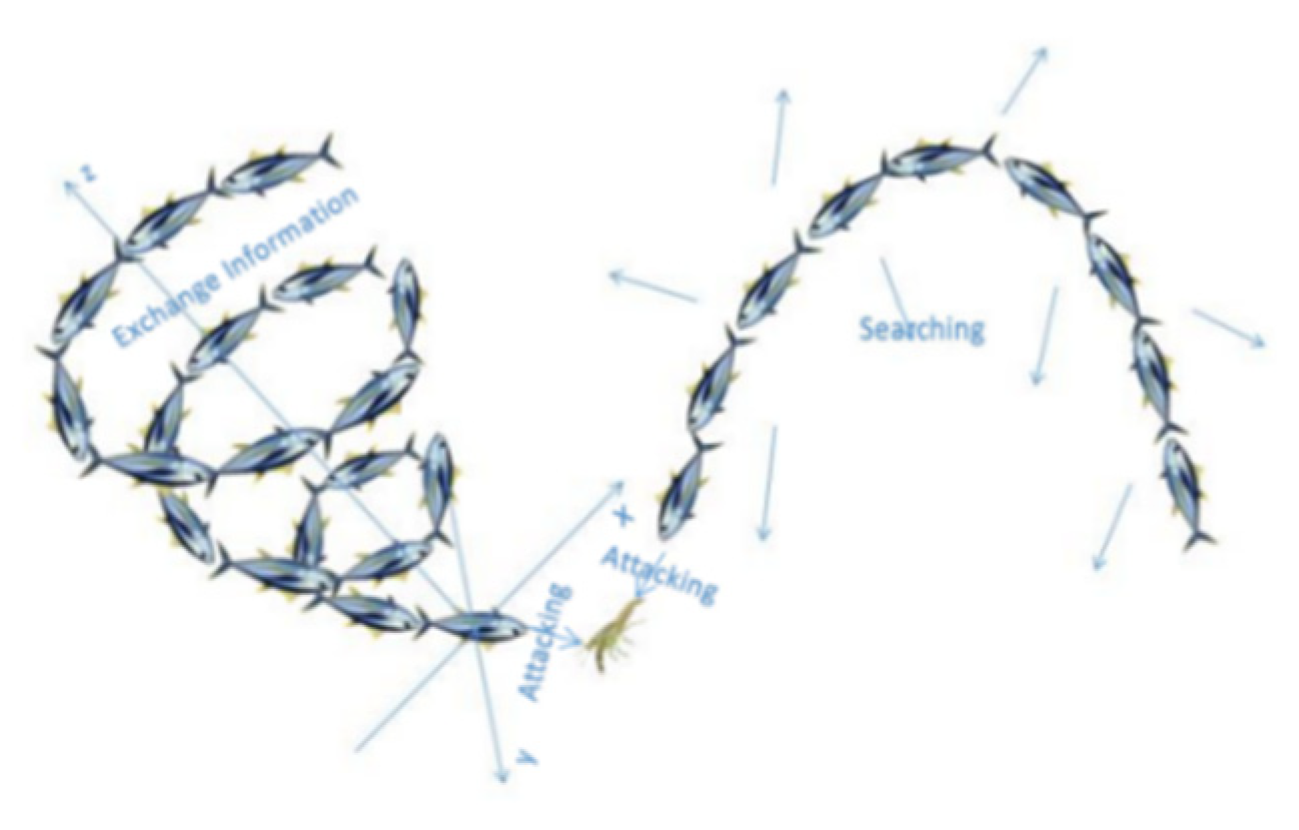

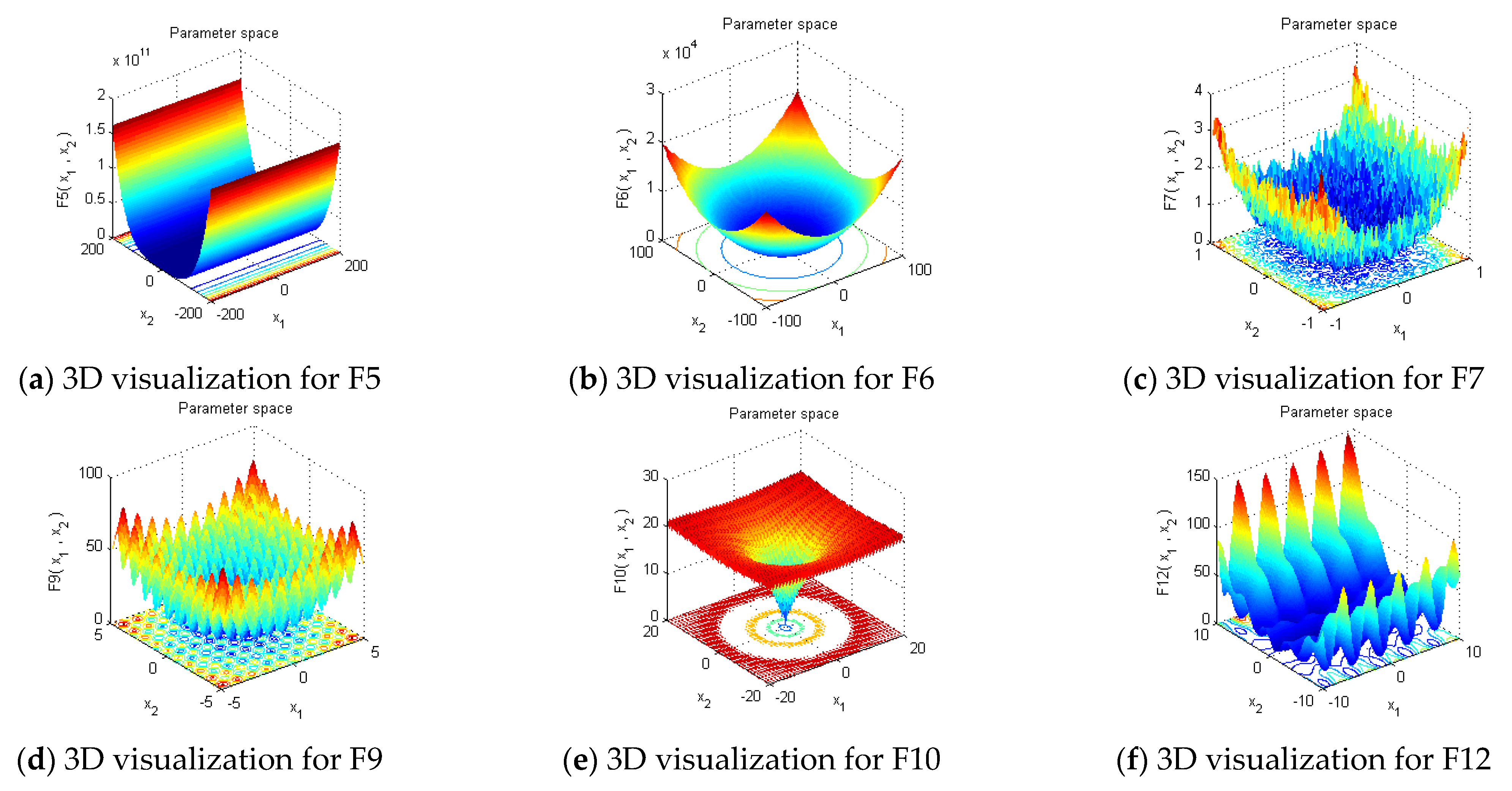
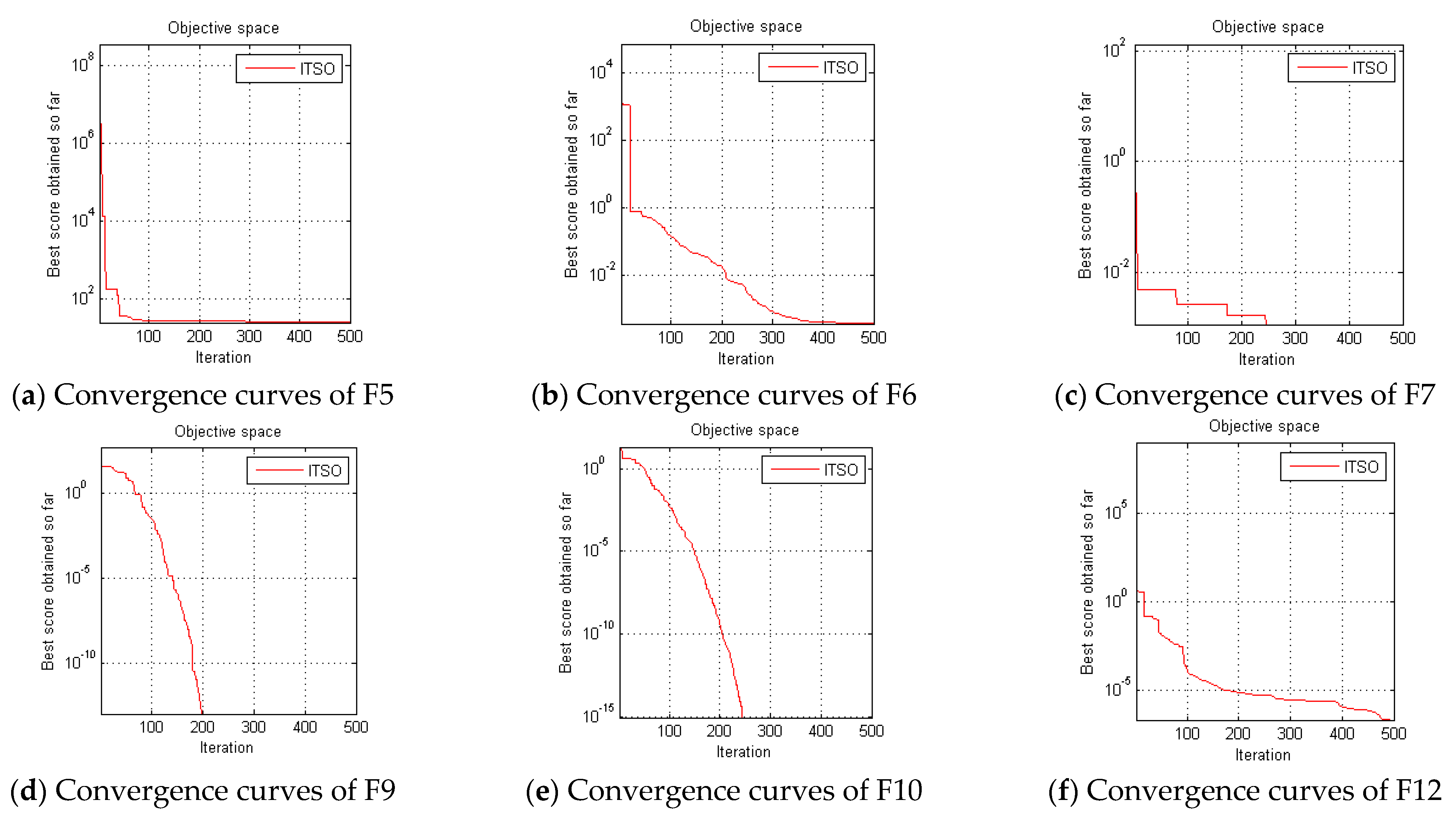
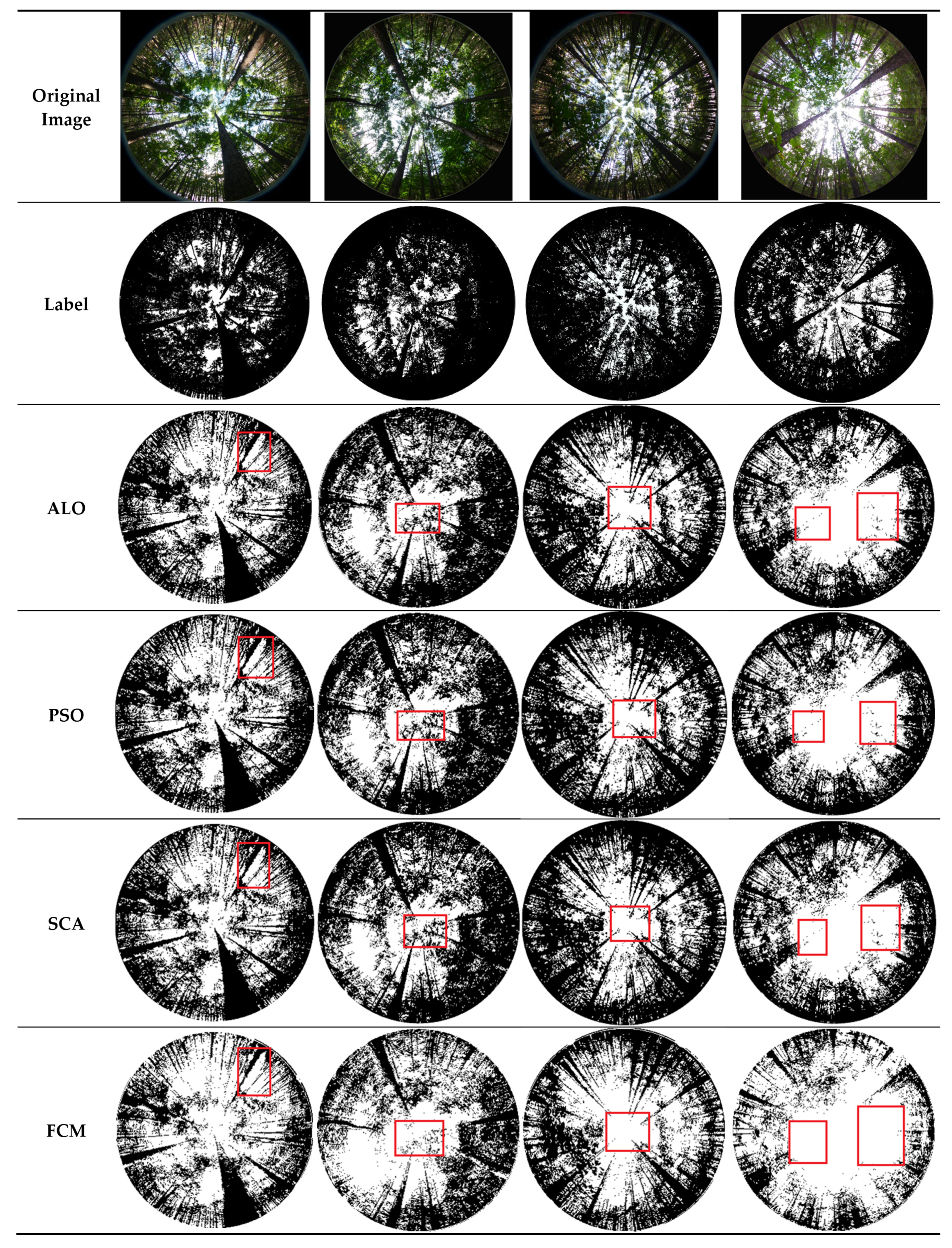
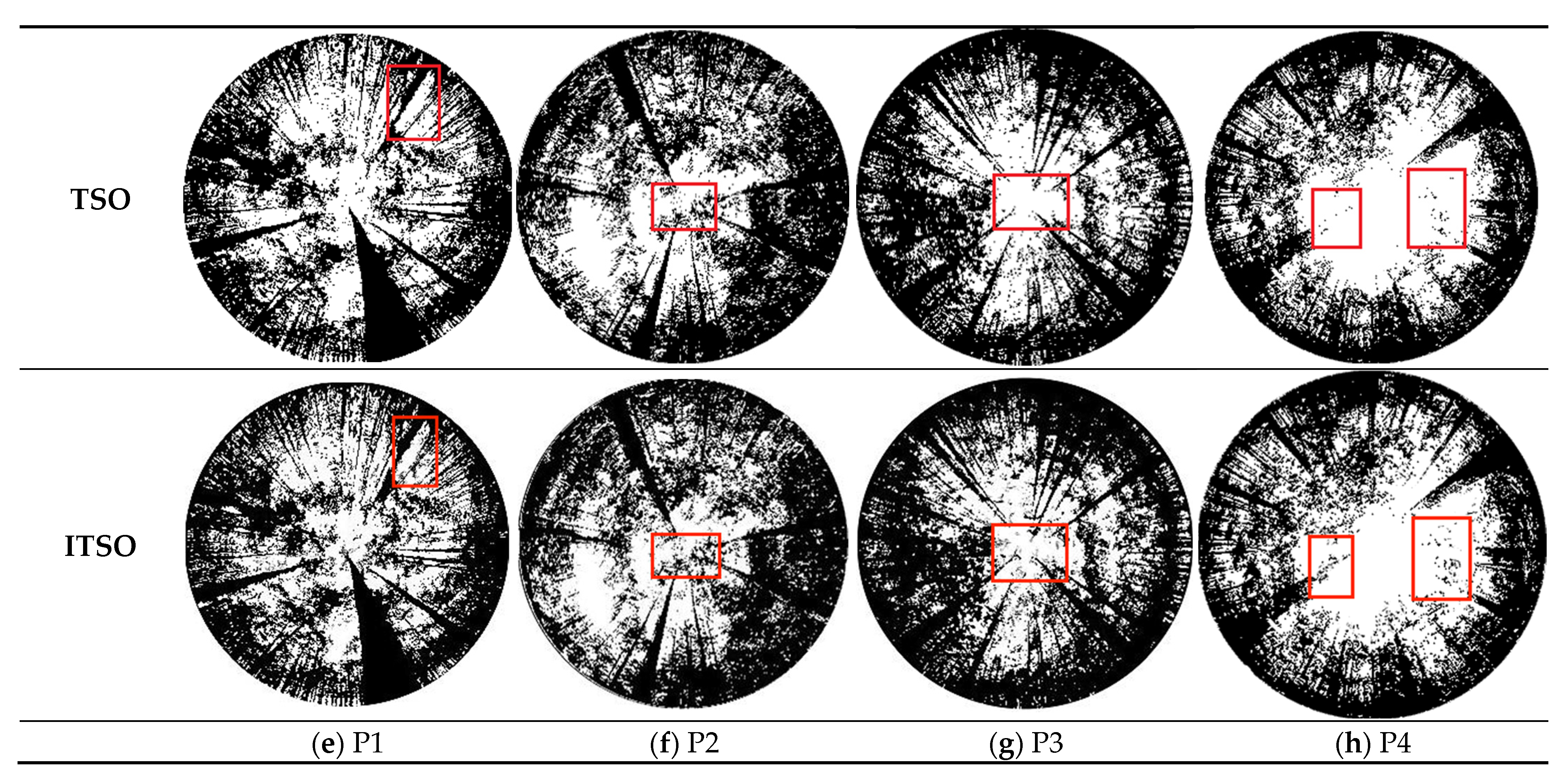
| Algorithm | Parameter Settings |
|---|---|
| ALO | n = 20, Max_iter = 500 |
| PSO | n = 20, c1 = 2, c2 = 2, ωmin = 0.4, ωmax = 0.9, vmin = − 4, vmax = 4, Max_iter = 500 |
| SCA | n = 20, a = 2, Max_iter = 500 |
| TSO | n = 20, z = 0.05, a = 0.7, Max_iter = 500 |
| ITSO | n = 20, z = 0.05, a = 0.7, Max_iter = 500 |
| Functions | Range | Optimum |
|---|---|---|
| [−30, 30] | 0 | |
| [−1.28, 1.28] | 0 | |
| [−500, 500] | 0 | |
| [−5.12, 5.12] | 0 | |
| [−32, 32] | 8.8818 × 10−16 | |
| [−50, 50] | 0 |
| Functions | ITSO | TSO | ALO | PSO | SCA | |
|---|---|---|---|---|---|---|
| F5 | ave | 0.015464536 | 4.924327909 | 178.5090674 | 458849038.7 | 2763.174333 |
| std | 0.0180 | 10.9867 | 137.4026 | 8.3121 × 107 | 2.5687 × 103 | |
| F6 | ave | 0.000171184 | 0.000248513 | 0.000905686 | 68804.49361 | 16.27245885 |
| std | 3.0774 × 10−4 | 1.9799 × 10−4 | 8.4144 × 10−4 | 1.6570 × 104 | 10.5434 | |
| F7 | ave | 0.000277808 | 0.000465939 | 0.275614442 | 203.776266 | 0.122350799 |
| std | 2.5701 × 10−4 | 3.5117 × 10−4 | 0.1608 | 65.6658 | 0.1124 | |
| F9 | ave | 0 | 0 | 101.6848638 | 286.3423714 | 60.00056188 |
| std | 0 | 0 | 31.5210 | 46.0670 | 46.2836 | |
| F10 | ave | 8.88 × 10−16 | 8.88 × 10−16 | 3.397571066 | 19.96145058 | 20.25331371 |
| std | 0 | 0 | 1.9911 | 0.0021 | 0.0639 | |
| F12 | ave | 1.05 × 10−6 | 1.39 × 10−6 | 12.29834499 | 1382400653 | 5.708549073 |
| std | 1.5672 × 10−6 | 2.2229 × 10−6 | 6.1491 | 2.2897 × 108 | 6.0366 | |
| Original Image | Histogram | Original Image | Histogram |
|---|---|---|---|
 | 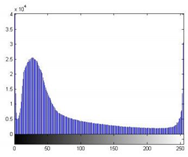 | 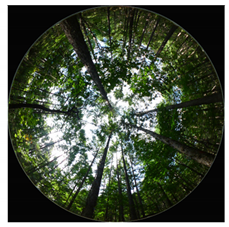 |  |
| (a) P1 | (b) P2 | ||
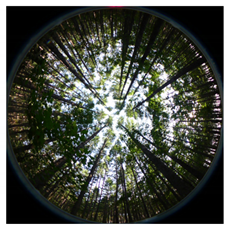 | 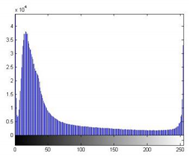 | 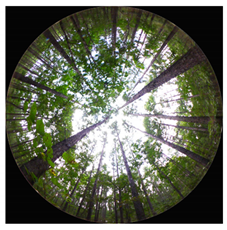 | 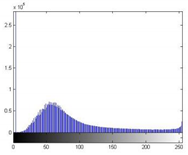 |
| (c) P3 | (d) P4 | ||
| Evaluation Criteria | Image | ALO | PSO | SCA | FCM | TSO | ITSO |
|---|---|---|---|---|---|---|---|
| MAE | 1 | 0.0317 | 0.0318 | 0.0321 | 0.0393 | 0.0326 | 0.0294 |
| 2 | 0.0297 | 0.0296 | 0.0295 | 0.0383 | 0.0300 | 0.0291 | |
| 3 | 0.0285 | 0.0290 | 0.0292 | 0.0363 | 0.0291 | 0.0268 | |
| 4 | 0.035 | 0.0349 | 0.0352 | 0.0469 | 0.0341 | 0.0341 | |
| ave | 0.031225 | 0.031325 | 0.0315 | 0.0402 | 0.03145 | 0.02985 | |
| RVD | 1 | 0.5332 | 0.5388 | 0.5538 | 0.9003 | 0.5769 | 0.4223 |
| 2 | 0.6520 | 0.6479 | 0.6418 | 1.1331 | 0.6742 | 0.6209 | |
| 3 | 0.5347 | 0.5632 | 0.5722 | 0.9582 | 0.5661 | 0.4458 | |
| 4 | 0.6600 | 0.6550 | 0.6714 | 1.2258 | 0.6190 | 0.6158 | |
| ave | 0.594975 | 0.601225 | 0.6098 | 1.0544 | 0.60905 | 0.5262 | |
| IoU | 1 | 0.5122 | 0.5029 | 0.5253 | 0.4366 | 0.5173 | 0.5548 |
| 2 | 0.5803 | 0.5671 | 0.5861 | 0.4457 | 0.5727 | 0.5690 | |
| 3 | 0.5950 | 0.5672 | 0.5940 | 0.4821 | 0.5824 | 0.6488 | |
| 4 | 0.5824 | 0.6001 | 0.596 | 0.4657 | 0.6246 | 0.5984 | |
| ave | 0.567475 | 0.559325 | 0.57535 | 0.457525 | 0.57425 | 0.59275 | |
| ASD | 1 | 2.7874 | 2.9714 | 2.9753 | 4.2495 | 2.5574 | 2.4434 |
| 2 | 4.1070 | 4.0482 | 3.9844 | 6.6649 | 4.0588 | 4.0750 | |
| 3 | 1.9287 | 2.1108 | 2.0575 | 3.3138 | 1.9967 | 1.4743 | |
| 4 | 2.8463 | 2.8692 | 2.767 | 4.9834 | 2.3623 | 2.5472 | |
| ave | 2.91735 | 2.9999 | 2.94605 | 4.8029 | 2.7438 | 2.634975 |
Publisher’s Note: MDPI stays neutral with regard to jurisdictional claims in published maps and institutional affiliations. |
© 2022 by the authors. Licensee MDPI, Basel, Switzerland. This article is an open access article distributed under the terms and conditions of the Creative Commons Attribution (CC BY) license (https://creativecommons.org/licenses/by/4.0/).
Share and Cite
Wang, J.; Zhu, L.; Wu, B.; Ryspayev, A. Forestry Canopy Image Segmentation Based on Improved Tuna Swarm Optimization. Forests 2022, 13, 1746. https://doi.org/10.3390/f13111746
Wang J, Zhu L, Wu B, Ryspayev A. Forestry Canopy Image Segmentation Based on Improved Tuna Swarm Optimization. Forests. 2022; 13(11):1746. https://doi.org/10.3390/f13111746
Chicago/Turabian StyleWang, Jingyu, Liangkuan Zhu, Bowen Wu, and Arystan Ryspayev. 2022. "Forestry Canopy Image Segmentation Based on Improved Tuna Swarm Optimization" Forests 13, no. 11: 1746. https://doi.org/10.3390/f13111746
APA StyleWang, J., Zhu, L., Wu, B., & Ryspayev, A. (2022). Forestry Canopy Image Segmentation Based on Improved Tuna Swarm Optimization. Forests, 13(11), 1746. https://doi.org/10.3390/f13111746





